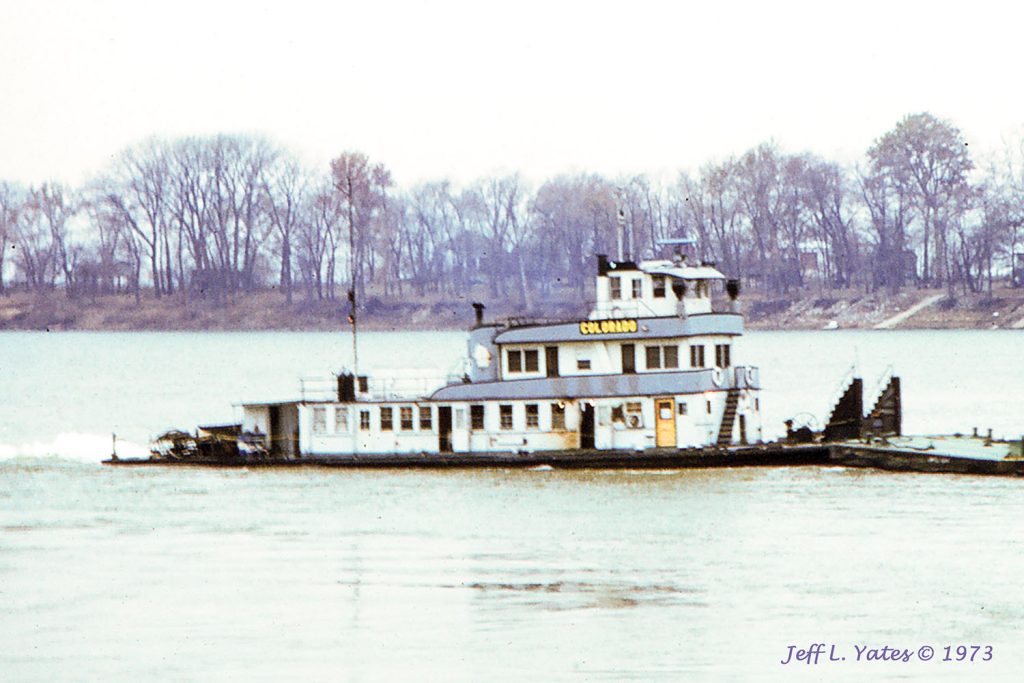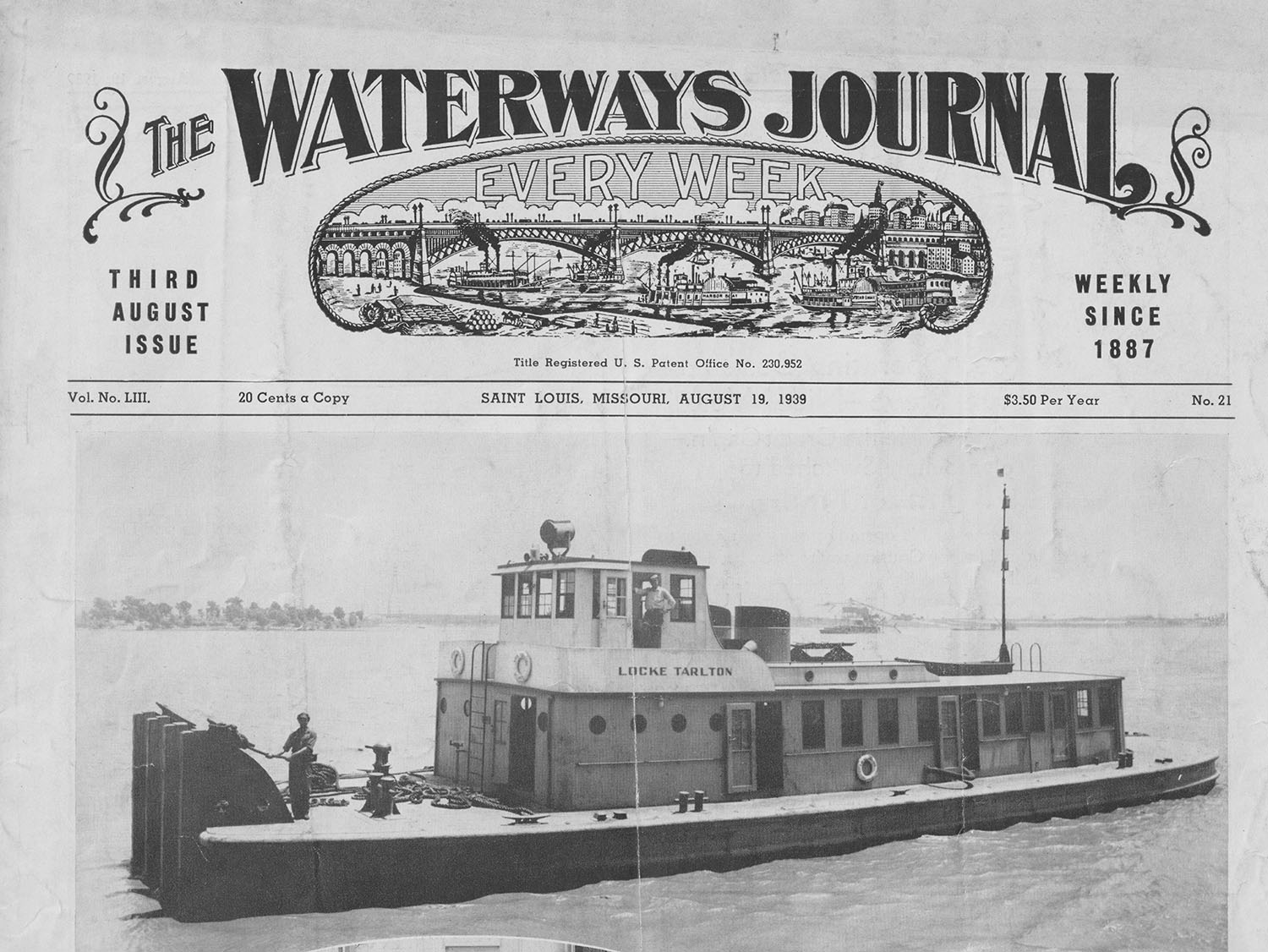The 1930s saw great technological advancement in the river industry, and in towboat construction in particular. Steam was still predominant for large boats, but diesel power was becoming more prevalent. By 1939, The Waterways Journal had detailed new towboats built by inland river shipyards entering service from the Herbert Hoover of 1931 (WJ November 25, 2021), the largest diesel prop boat in service at 2,200 hp., to the steam sternwheel Alexander Mackenzie (WJ October 9, 2023), rated at 1,600 hp. In between were smaller diesel boats such as the Dravo-built Peace of 1934 and the St. Louis-built Alice M. Tyler, both rated at 750 hp.
The July 29, 1939, issue of the WJ announced yet another diesel towboat for the river system, but this one had not been built at one of the many shipyards located along the banks of the rivers, but at one located on the Great Lakes. This shipyard was the Burger Boat Company of Manitowoc, Wis. Burger had roots back to 1863, and it continues in business today. While it has built a wide range of vessels over the years, it is primarily known as a builder of custom yachts.
The towboat that Burger built in 1939 was the Locke Tarlton, crafted for the Missouri-Illinois Materials Company and named for the president of the firm. The boat was of all-steel and welded construction with a model-bow hull described as being 97 by 27 feet. It was powered by a pair of Fairbanks-Morse five-cylinder Model 37 direct-drive diesels, each rated 500 hp. at 400 rpm., turning cast steel propellers that were 68 inches in diameter with 42-inch pitch.
The Tarlton was designed by marine architect A.M. Deering of Chicago, and he attended the launching of the boat on May 2, 1939. The new vessel had a single cabin surmounted by a raised pilothouse. Behind the pilothouse were two short smokestacks. The crew quarters had been left unfinished, as the WJ article said the boat would be engaged in towing for Federal Barge Line within the St. Louis harbor. A galley was provided forward of the engineroom, and once quarters were completed it would have accommodation for a crew of 14. It had arrived at St. Louis on May 28, 1939, with the crew listed as Capt. John Marsh, master-pilot; James Scott, chief engineer; and John Henke, deckhand.
The Locke Tarlton was sold in 1944 to Streett Towing Company, St. Louis, owed by J.D. Streett Oil Company. It joined the Mokita and Papoose, both built by Erlbacher and owned by Streett. It may have been at this time that the boat was extensively rebuilt. A second cabin was added, and the pilothouse placed on top of that. The stacks were either replaced or enlarged, and the name was changed to Zephyr, which was the Streett brand of gasoline. Following the rebuilding, the length of the boat was shown as 102 feet.
Streett Towing would rapidly expand its fleet throughout the 1940s and 1950s, and in 1948 the Zephyr was repowered with a pair of GM 12-567 diesels totaling 2,400 hp. The name was changed at this time to Alton Zephyr, reflecting Streett’s new practice of naming its boats after cities that it serviced, followed by “Zephyr.” In time, in addition to the Alton Zephyr, Streett would have the Cape Zephyr, Havana Zephyr, Memphis Zephyr and St. Louis Zephyr.
In 1954, the Alton Zephyr was sold to the Comet River Company, owned by Tresler Oil Company, Cincinnati. For the majority of the next two decades, it would be a fixture on the Ohio River, usually towing a four-piece tank barge unit composed of barges named Chuck, Lang, Shad and Johnna B. It was often at Catlettsburg, Ky., where this writer grew up and the radio call letters of WB 4683 became very familiar. My maternal grandmother was on it as a trip cook in the early 1970s, and it was the first of many boats she would work on over the years.
In December 1972, the boat was sold to Interstate Marine Services Inc. of Pittsburgh and renamed Hawk. I knew that the boat had burned after this, but my memory was fuzzy about the events after 50-plus years. Digging through research material, I found that the Hawk was last listed in the 1973 edition of the Inland River Record. Capt. Fred Way, originator of the book, had ceased including an “Off The Record” section in the 1960s, and that wouldn’t resume until Dan Owen resumed the practice when he became editor in 1977. I perused the December 15, 1973, Annual Review issue of the WJ, and I found no mention of it in the “Boats Lost” column, but did see one listed there named Colorado, and it was 2,400 hp.
The Colorado sparked a dim memory, and I turned to a trusted source, Capt. Jeff Yates. Yates absolutely had the information needed. He had a file on the Colorado, and it WAS the former Alton Zephyr. A clipping he had from the November 24, 1973, issue of the WJ said that the boat had been renamed Colorado while undergoing repairs at Hartford, Ill., on November 15. Five days later, Yates caught a photo of it as it was passing his hometown of Henderson, Ky., upbound on November 20. It may be a very rare photo as another clipping from the December 15, 1973, WJ (which I had missed when I was leafing through the 188-page Annual Review issue) that said the Colorado, formerly the Alton Zephyr and Hawk, had burned on December 5, 1973, and was beached on the right bank at Mile 268.4 on the Lower Mississippi River.

At the time of the fire, the WJ story said that the boat had recently been purchased by and was being operated by Colorado Towing Company, St. Louis. The fire must have rendered the vessel a total loss as it was never rebuilt. A big thank you to Capt. Jeff Yates for finding it important enough to file these obscure news stories 50 years ago.
Caption for top photo (click on image for full photo): The Locke Tarlton in a Fairbanks-Morse ad on the cover of the August 18, 1939, WJ. (Author’s collection)
Capt. David Smith can be contacted at davidsmith1955obc@gmail.com.



